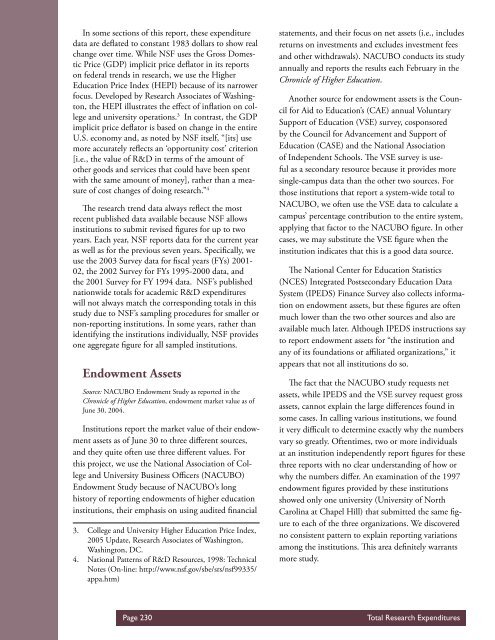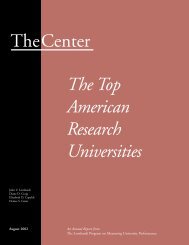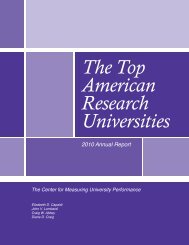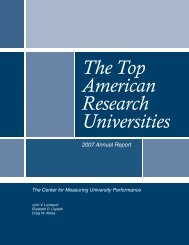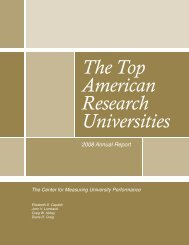TheCenter The Top American Research Universities
2005 - The Center for Measuring University Performance - Arizona ...
2005 - The Center for Measuring University Performance - Arizona ...
You also want an ePaper? Increase the reach of your titles
YUMPU automatically turns print PDFs into web optimized ePapers that Google loves.
In some sections of this report, these expendituredata are deflated to constant 1983 dollars to show realchange over time. While NSF uses the Gross DomesticPrice (GDP) implicit price deflator in its reportson federal trends in research, we use the HigherEducation Price Index (HEPI) because of its narrowerfocus. Developed by <strong>Research</strong> Associates of Washington,the HEPI illustrates the effect of inflation on collegeand university operations. 3 In contrast, the GDPimplicit price deflator is based on change in the entireU.S. economy and, as noted by NSF itself, “[its] usemore accurately reflects an ‘opportunity cost’ criterion[i.e., the value of R&D in terms of the amount ofother goods and services that could have been spentwith the same amount of money], rather than a measureof cost changes of doing research.” 4<strong>The</strong> research trend data always reflect the mostrecent published data available because NSF allowsinstitutions to submit revised figures for up to twoyears. Each year, NSF reports data for the current yearas well as for the previous seven years. Specifically, weuse the 2003 Survey data for fiscal years (FYs) 2001-02, the 2002 Survey for FYs 1995-2000 data, andthe 2001 Survey for FY 1994 data. NSF’s publishednationwide totals for academic R&D expenditureswill not always match the corresponding totals in thisstudy due to NSF’s sampling procedures for smaller ornon-reporting institutions. In some years, rather thanidentifying the institutions individually, NSF providesone aggregate figure for all sampled institutions.Endowment AssetsSource: NACUBO Endowment Study as reported in theChronicle of Higher Education, endowment market value as ofJune 30, 2004.Institutions report the market value of their endowmentassets as of June 30 to three different sources,and they quite often use three different values. Forthis project, we use the National Association of Collegeand University Business Officers (NACUBO)Endowment Study because of NACUBO’s longhistory of reporting endowments of higher educationinstitutions, their emphasis on using audited financial3. College and University Higher Education Price Index,2005 Update, <strong>Research</strong> Associates of Washington,Washington, DC.4. National Patterns of R&D Resources, 1998: TechnicalNotes (On-line: http://www.nsf.gov/sbe/srs/nsf99335/appa.htm)statements, and their focus on net assets (i.e., includesreturns on investments and excludes investment feesand other withdrawals). NACUBO conducts its studyannually and reports the results each February in theChronicle of Higher Education.Another source for endowment assets is the Councilfor Aid to Education’s (CAE) annual VoluntarySupport of Education (VSE) survey, cosponsoredby the Council for Advancement and Support ofEducation (CASE) and the National Associationof Independent Schools. <strong>The</strong> VSE survey is usefulas a secondary resource because it provides moresingle-campus data than the other two sources. Forthose institutions that report a system-wide total toNACUBO, we often use the VSE data to calculate acampus’ percentage contribution to the entire system,applying that factor to the NACUBO figure. In othercases, we may substitute the VSE figure when theinstitution indicates that this is a good data source.<strong>The</strong> National Center for Education Statistics(NCES) Integrated Postsecondary Education DataSystem (IPEDS) Finance Survey also collects informationon endowment assets, but these figures are oftenmuch lower than the two other sources and also areavailable much later. Although IPEDS instructions sayto report endowment assets for “the institution andany of its foundations or affiliated organizations,” itappears that not all institutions do so.<strong>The</strong> fact that the NACUBO study requests netassets, while IPEDS and the VSE survey request grossassets, cannot explain the large differences found insome cases. In calling various institutions, we foundit very difficult to determine exactly why the numbersvary so greatly. Oftentimes, two or more individualsat an institution independently report figures for thesethree reports with no clear understanding of how orwhy the numbers differ. An examination of the 1997endowment figures provided by these institutionsshowed only one university (University of NorthCarolina at Chapel Hill) that submitted the same figureto each of the three organizations. We discoveredno consistent pattern to explain reporting variationsamong the institutions. This area definitely warrantsmore study.Page 230Total <strong>Research</strong> Expenditures


